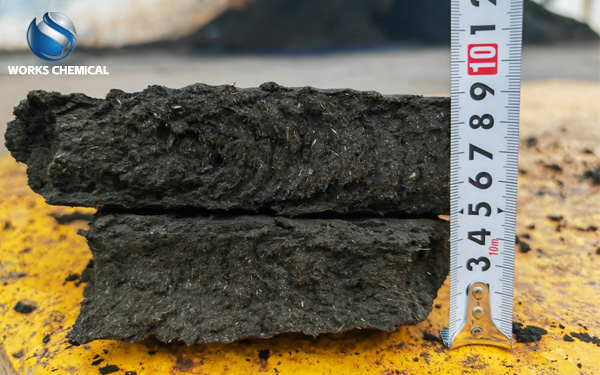
The papermaking industry generates a large amount of sludge during the production process. These sludges are complex in composition and difficult to treat, which has always been an environmental protection problem plaguing enterprises. In recent years, the emergence of sludge enhancers has brought new hope for the effective treatment of papermaking sludge. The remarkable effects they have demonstrated in the treatment of papermaking sludge have attracted extensive attention within the industry.

The characteristics and treatment difficulties of papermaking sludge
Papermaking sludge mainly comes from the production processes such as pulping and papermaking. Its composition varies due to differences in raw materials and production processes, but generally has the following characteristics. Firstly, the moisture content is extremely high, usually above 95%, and in some cases even reaching 98%, which makes the volume of sludge huge and the transportation and disposal costs high. Secondly, it contains a large amount of fibers, lignin, fillers and residual chemical agents, etc. The presence of fibers and lignin makes the sludge structure loose and water difficult to separate. Furthermore, the organic matter content in papermaking sludge is relatively high, which is prone to decay and deterioration, generating malodorous gases and causing pollution to the surrounding environment.
The traditional methods for treating papermaking sludge have many limitations. The dehydration efficiency of natural drying is extremely low, it is greatly affected by the weather, and it requires a large amount of space. Although mechanical dewatering is widely applied, due to the special properties of papermaking sludge, it is difficult to reduce the moisture content to the ideal level merely by relying on traditional treatments such as flocculants. Often, the moisture content of the sludge remains above 80% after dewatering, and subsequent disposal methods such as landfill and incineration still face considerable pressure. In addition, traditional treatment methods may also lead to the inability to effectively remove harmful substances in sludge, posing a risk of secondary pollution.
The mechanism of action of sludge enhancers in treating papermaking sludge
The reason why sludge enhancers can play a significant role in the treatment of papermaking sludge is inseparable from their unique mechanism of action. It is composed of multiple components working together and precisely treats the characteristics of papermaking sludge.
For the large amount of fibers and lignin in papermaking sludge, the structural modification components in sludge enhancers can play an important role. These components can alter the surface properties of fibers and lignin, disrupt the binding force between them, make the originally loose sludge structure more compact, and promote the agglomeration of sludge particles. The size of the sludge particles after agglomeration increases, and their sedimentation performance is improved, creating favorable conditions for the subsequent dewatering treatment.
Meanwhile, the wall-breaking and degreasing components in the sludge efficiency enhancer can effectively decompose the organic matter in the sludge. The organic matter in papermaking sludge is closely combined with water, forming bound water that is difficult to remove. The wall-breaking components can disrupt the cellular structure of organic matter, causing the bound water to be released. The degreasing components can dissolve the oily substances on the surface of organic matter, further enhancing the efficiency of water separation.
The remarkable effect of sludge enhancers in the treatment of papermaking sludge
Significantly reduce the moisture content to achieve sludge reduction
In the treatment of papermaking sludge, sludge enhancers can significantly reduce the moisture content of sludge from over 95% to 50%-60%, or even lower. When a large-scale papermaking enterprise did not use sludge enhancers, it adopted plate and frame filter presses to dewater the papermaking sludge. After treatment, the moisture content of the sludge remained at around 80%, and the daily sludge production reached 500 tons. After the introduction of the sludge enhancer, after being treated by the same plate and frame filter press, the moisture content of the sludge was reduced to 55%, the daily sludge volume was reduced to about 200 tons, and the sludge volume was reduced by nearly 60%, greatly lowering the transportation and disposal costs of the sludge.
Improve processing efficiency and reduce operating costs
After using the sludge enhancer, the dewatering speed of papermaking sludge was significantly accelerated, and the treatment cycle was shortened. Before the above-mentioned papermaking enterprises used the enhancer, the filtration time for each batch of sludge was 4 hours, but after the application, it only took 2 hours, doubling the treatment efficiency. Meanwhile, as the sludge enhancer has improved the filtration performance of the sludge and reduced the clogging of the filter cloth, the replacement frequency of the filter cloth has been extended from once a week to once a month, lowering the maintenance cost of the equipment and the procurement cost of the filter cloth. According to statistics, the enterprise can save about 50,000 yuan per month on equipment maintenance and filter cloth replacement costs.
Reducing pollutant emissions is conducive to subsequent disposal
After being treated with sludge enhancers, the harmful substances in the papermaking sludge have been solidified and stabilized to a certain extent, reducing the risk of pollutant emissions in the subsequent disposal process. When the treated sludge is incinerated, due to its low moisture content, it burns more completely, which not only improves the heat utilization rate but also reduces the emission of harmful gases such as dioxins. In addition, some of the treated sludge, after further processing, can also be used to make building materials, etc., achieving the resource utilization of sludge. A certain paper mill mixed the treated sludge with other raw materials to make environmentally friendly bricks, which not only solved the problem of sludge disposal but also created certain economic benefits.